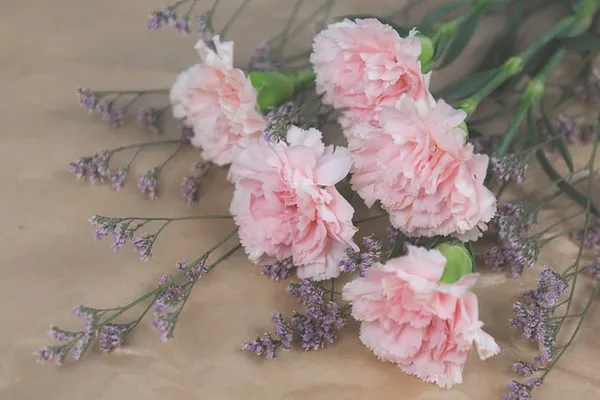The carnation flower, known for its delicate petals and enchanting fragrance, holds a special place in the world of floristry and symbolism. With its rich history and diverse cultural significance, the carnation has captivated the hearts of many around the globe. One of the most common questions asked about this beautiful flower is, “Which month is the carnation flower?” In this comprehensive article, we will explore the origins, meanings, and significance of the carnation flower, as well as delve into the month associated with this beloved bloom.
Origins and Botanical Characteristics
Before delving into the month associated with the carnation flower, it is essential to understand its origins and botanical characteristics. The carnation, scientifically known as Dianthus caryophyllus, belongs to the Caryophyllaceae family. Native to the Mediterranean region, this perennial plant is characterized by its slender stems, narrow leaves, and clustered blooms.
Carnations are available in a spectrum of colors, including white, red, pink, yellow, and purple, each carrying its unique symbolism and meaning. The flower’s scientific name, Dianthus, originates from Greek words “dios,” meaning divine, and “anthos,” meaning flower, emphasizing its divine beauty and elegance.
Cultural and Symbolic Significance
Throughout history, the carnation flower has been revered for its cultural and symbolic significance across various civilizations. In ancient Greece, the carnation was associated with the love goddess Aphrodite and often used in ceremonial garlands and decorations during festivities and celebrations.
During the Renaissance period in Europe, carnations gained popularity as a symbol of love and fascination, often exchanged between lovers as a token of affection. In Victorian England, the language of flowers, also known as floriography, became popular, and carnations were used to convey messages of love, admiration, and gratitude.
In many cultures around the world, carnations are also associated with Mother’s Day, symbolizing maternal love and gratitude. The tradition of wearing carnations on Mother’s Day originated in the United States in the early 20th century and has since spread to various countries worldwide.
The Month of the Carnation Flower
Now, let us explore the month associated with the carnation flower. The carnation is traditionally recognized as the birth flower for the month of January. As such, individuals born in January are often represented by the carnation, symbolizing qualities such as love, admiration, and distinction.
However, it is essential to note that carnations are available year-round in many parts of the world due to modern agricultural practices and greenhouse cultivation. As a result, carnations are not limited to a specific month but can be enjoyed and appreciated throughout the year.
Carnation Varieties and Meanings by Color
As mentioned earlier, carnations are available in a wide range of colors, each carrying its unique symbolism and meaning. Let us explore some of the most common carnation varieties and their associated meanings:
White Carnations: White carnations symbolize purity, innocence, and spirituality. They are often used in wedding bouquets and religious ceremonies to represent purity of heart and eternal love.
Red Carnations: Red carnations are a symbol of deep love, admiration, and affection. They are commonly exchanged on Valentine’s Day and anniversaries as a declaration of passionate love and desire.
Pink Carnations: Pink carnations represent admiration, gratitude, and affection. They are often given as gifts to express appreciation and admiration for someone special.
Yellow Carnations: Yellow carnations symbolize friendship, joy, and happiness. They are ideal for celebrating friendship and brightening someone’s day with their cheerful color.
Purple Carnations: Purple carnations symbolize royalty, elegance, and luxury. They are often used in arrangements for formal events and to convey a sense of regal sophistication.
Carnation Care and Maintenance
To ensure the longevity and beauty of carnation flowers, proper care and maintenance are essential. Here are some tips for caring for carnations:
Watering: Carnations require regular watering to keep the soil moist but not waterlogged. Water the plants at the base to avoid getting the foliage wet, as this can lead to fungal diseases.
Sunlight: Carnations thrive in full sunlight or partial shade. Place them in a location where they can receive at least six hours of sunlight per day for optimal growth and blooming.
Fertilization: Use a balanced fertilizer formulated for flowering plants to promote healthy growth and abundant blooms. Apply the fertilizer according to the manufacturer’s instructions during the growing season.
Pruning: Deadhead spent flowers regularly to encourage continuous blooming and prevent the plant from wasting energy on seed production. Trim any yellowing or diseased foliage to maintain plant health.
Pest and Disease Control: Keep an eye out for common pests such as aphids, spider mites, and thrips, which can damage carnation plants. Treat infestations promptly with insecticidal soap or neem oil to prevent further damage.
By following these care tips, you can enjoy vibrant and healthy carnation flowers in your garden or home throughout the year.
Conclusion
The carnation flower holds a special place in the hearts of many due to its beauty, fragrance, and rich symbolism. While traditionally associated with the month of January as the birth flower, carnations are cherished and appreciated year-round for their versatility and diverse meanings.
Whether used in floral arrangements for weddings, celebrations, or as tokens of love and appreciation, carnations continue to captivate and inspire people around the world. With proper care and maintenance, these beloved blooms will continue to brighten our lives with their timeless beauty and elegance.


